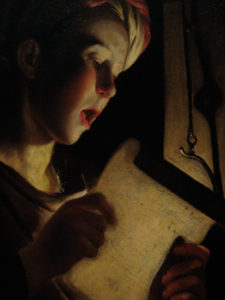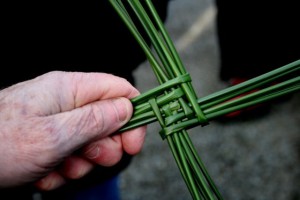It happens to be snowing like mad across the northeastern United States as I sit and write this. Be that as it may, with the arrival of February, we take our first step onto the bridge that leads us from winter to spring. This first day of the month brings St. Brigid’s Day: Brigid, the bridge. She bids us welcome upon the next spoke in the wheel of the year, and there is a lot to talk about today: past, present, and future. Are you ready? Ok, then. Here we go:
We’ll begin with what is passing: If you––like Seth and me in this house––have been delighting in Christmas all this month, now comes the time to put Yuletide behind us and to shift our perspective toward spring. Forty days have passed since the Midwinter solstice and we are now halfway from there to the vernal equinox in March. As such, St. Brigid brings us a new cross quarter day, for Yuletide ends and Imbolc begins. With this shift of the wheel, tradition would have us remove all vestiges of Christmas greenery by Candlemas Eve, which comes with tonight’s setting sun. While the major festivities and revelry of Christmas traditionally ended with Epiphany (the Twelfth Day of Christmas), the spirit of the season remained and lingered and kept folks company for all these forty wintry days. But it was considered bad luck to keep these Yuletide things about the house any longer than Candlemas Eve. Our old reliable 17th century Book of Days poet Robert Herrick describes the significance of this night in his poem “Ceremony Upon Candlemas Eve”:
Down with the rosemary, and so
Down with the bays and misletoe;
Down with the holly, ivy, all,
Wherewith ye dress’d the Christmas Hall:
That so the superstitious find
No one least branch there left behind:
For look, how many leaves there be
Neglected, there (maids, trust to me)
So many goblins you shall see.
And so our tree will be brought outside this first night of February, as will the wreath that’s been hanging on the door. We return to nature what is hers. We’ll keep the tree in a quiet corner of the yard––easy to do here, since our yard is a bit of forest––and all the year long it will remind of us of Christmas whenever we by chance brush against it and get a whiff of its balsam fragrance. And when the nights grow long again next December, it will fuel our solstice fire, connecting one Christmas to the next. Ah, but that is the future, and for now, if Christmas is what we are leaving behind, let’s focus next on the present.
ST. BRIGID’S DAY, IMBOLC
There are four cross quarter days in the year; each is marked by accompanying holydays/holidays. The one we most recently celebrated was at the end of October and start of November: Halloween, All Saints Day, and All Souls Day––the Days of the Dead. We were approaching winter; life was descending below the earth. But today, as February begins, the wheel of the year shifts and we reach the next period of cross quarter days, marking the first stirrings of earth’s awakening on the approach to spring. Winter still has a firm grip, to be sure, but one thing to keep in mind with these traditional ways of reckoning time is they are always a small step ahead of the game. In this reckoning, the equinox in March will mark the height of spring… and so spring’s beginnings start here, as January melts into February.
St. Brigid, sacred to Ireland and second in stature there only to St. Patrick, is honored on the First of February. In the older earthbound religions, the day honors the Celtic goddess Brigid and brings the season of Imbolc. As the goddess goes, the old crone of winter is reborn now as the young maiden, for this is a time of renewal. The seeds that were planted beneath the earth last fall are preparing to bring forth lush green life, once spring truly arrives. For St. Brigid’s Day, it is traditional to fashion a St. Brigid’s Cross out of rushes or reeds (pictured below), as well as to leave an oat cake and butter on a windowsill in your home. This, to encourage Brigid to visit your home and bless all who live there. Brigid is typically depicted holding her cross of rushes in one hand and an illuminated lamp in the other––bridging, again, the themes of light in the darkness of midwinter with the green of approaching spring.
CANDLEMAS, GROUNDHOG DAY
Once the sun sets on St. Brigid’s Day, we enter into Candlemas Eve. This is the night that all remaining Yuletide greenery is removed from the home (as Robert Herrick’s poem suggests), but it is traditional to keep nativity scenes up through Candlemas, the next day. I know many of you are reading and wondering how we could possibly still have Christmas in the house, but keep in mind that in this house our decorating did not begin in earnest until the days just before Christmas. We gave the Advent season its proper space and time and have done the same with Christmas. Keeping Christmas in the house longer than this, though, is not advised. Anyone who was the least bit superstitious would fear that doing so would invite bad luck into the home. Why take that chance?
For us, there is always a measure of mixed emotion over this cleaning up of Christmas. (My Uncle Joe used to explain “mixed emotions” to me as “watching your mother-in-law drive off a cliff in your brand new Eldorado”––but he was only joking; he loved his mother-in-law, my grandma Assunta.) It is nice to have a clean slate after all that Yuletide abundance and extravagance… but Seth and I are a bit in love with Christmas, and so it is sad each year to see it go. To make things less somber, we’ll have some Christmas music playing (again, keep in mind we’re generally not listening to Frosty the Snowman and Winter Wonderland but to older carols, like this one) and perhaps a bottle of St. Bernardus Christmas Ale open and flowing.
With Christmas removed (and ill luck kept at bay), we’ll shift perspective on the Second of February to Candlemas, a beautiful celebration in its own rite, and the second step on the bridge to spring that Brigid lays before us. Candlemas is the day that candles are blessed in the church, but it is also known as Purification Day, which harkens back to an old Hebrew tradition: forty days after the birth of a son, women would go to the temple to be purified. Again, renewal. And so Mary did this, for it was her tradition, and when she did, it was there at the temple that she and her infant child ran into the elders Simeon and Anna, who recognized the child as “the Light of the World.” This is the basis for the blessing of candles on this day, and the day’s lovely name, which is even more beautiful in other languages: la Candelaria in Spanish, la Chandeleur in French. In France, the traditional evening meal for la Chandeleur is crêpes. In Mexico, la Candelaria is a night for tamales and hot chocolate, while the procession and celebration in Puno, Peru, is typically so big, it rivals that of Carnival in Rio de Janeiro.
Candlemas celebrations this year certainly will be quiet and centered on home, which is ok by us. Yes, spring is coming as we find ourselves forty days past midwinter, but the darkness of those darkest nights still closely lingers, and the light of Candlemas remains a powerful metaphor. One of my favorite Candlemas traditions is to go through the house at sunset, lighting every lamp, even for just a few minutes. And my favorite song for the day is an old carol called “Jesus, the Light of the World.” Is it a carol for Candlemas? Who knows. Certainly the words echo those of Simon the Elder in the temple, so for me, I say it is.
Most famously, perhaps, Candlemas is known as an old weather marker. As the old saying goes: If the sun shines bright on Candlemas day / The half of the winter’s not yet away. The tradition of Candlemas as weather marker is particular strong in Germany. And while Candlemas itself is not celebrated with any great gusto here in the States, this remnant of tradition remains in our yearly observation on the Second of February of Groundhog Day, in which the observations of an old groundhog in Pennsylvania (where many Germans settled) determine how much longer winter will last. Did old Candlemas weather lore influence the traditions that revolve around Punxsutawney Phil? Of this we can be pretty certain.
ST. BLAISE’S DAY
Finally, to close out this luminous chapter, the Third of February will bring St. Blaise’s Day, and the traditions for St. Blaise’s Day, it would seem, come directly out of having all those candles about on Candlemas. For ailments of the throat, we pray to St. Blaise… and on his feast day, it is not uncommon to go to church to have the priest bless your throat by holding two candles, crossed into an X shape, with your throat in the crook of the candles, as he says a blessing over your head. It’s one of those mystical ceremonies that seems almost over the top even to us Catholics.
He is fondly remembered in my family, for St. Blaise was the name of the church my grandparents attended, up the hill from their home in Brooklyn. My Aunt Anne and Uncle Joe (the one who told the joke about the Eldorado and his mother-in-law) were married there, and so were my own parents. Folks with high aspirations, Mom says, went to the big cathedral up the road, but the simpler folks went to St. Blaise. It was a small church that served a small community made up mostly of Italian immigrants and their families. In England and Scotland, it was once customary to light bonfires on the eve of St. Blaise, which would be the night of Candlemas, and perhaps there is some connection to be made between Blaise and blaze. It is a day also important to wool carders (a matter having to do with St. Blaise’s martyrdom), as well as to spinners and dyers.
What is most apparent across these few days and nights upon the bridge that delivers us from winter to spring is the importance of light, be it in candle or bonfire or in song or even in those crêpes, whose golden round shape call to mind the image of the shining sun. Hide not your light, then. Be a light to the world. And rest assured that spring is on its way.
YOUR FEBRUARY BOOK of DAYS CALENDAR
This month’s Convivio Book of Days calendar awaits! It’s our monthly gift to you, a PDF document printable on standard US Letter size paper. You’ll find the calendar a fine companion to this blog; click here to get it. Enjoy!
SHOP OUR VALENTINE SALE!
Our best deal ever awaits you at our online shop: Spend $65 across our catalog and take $10 off, plus get free domestic shipping, when you enter discount code LOVEHANDMADE at checkout. That’s a total savings of $18.50. Click here to start shopping. We’ve got some wonderful new handmade artisan goods from Mexico (hand embroidered hearts, punched tin, Frida mirrors and crosses) and some brand new additions from the Sabbathday Lake Shakers, too (the most intoxicating potpourri, a recipe from 1858), to surprise your sweetheart and delight your darlin’. I think you’ll love what we’ve got in store at conviviobookworks.com… and your purchases translate into real support for real families, small companies, and artisans we know by name.
Images, from top: “Le Jeune Chanteur” by Trophime Bigot, who is known also as the Candlelight Master (oil on canvas, 1650 [Public domain] via Wikimedia Commons); a St. Brigid’s Cross fashioned from reeds; my mom and dad with some of their wedding party on their wedding day, May 29, 1949, outside St. Blaise Church in Brooklyn. Their flower girl was my cousin Cammie, who plays la Befana for the family each Epiphany. We all see each other every Sunday for a Cousins’ Zoom gathering, a new tradition we began at the start of quarantine last March.


